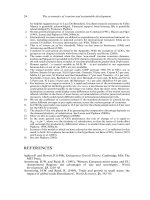THE ECONOMICS OF MONEY,BANKING, AND FINANCIAL MARKETS 388
Bạn đang xem bản rút gọn của tài liệu. Xem và tải ngay bản đầy đủ của tài liệu tại đây (45.76 KB, 1 trang )
356
PA R T I V
FYI
The Management of Financial Institutions
The Hunt Brothers and the Silver Crash
In early 1979, two Texas billionaires, W. Herbert
Hunt and his brother, Nelson Bunker Hunt,
decided that they were going to get into the
silver market in a big way. Herbert stated his
reasoning for purchasing silver as follows: I
became convinced that the economy of the
United States was in a weakening condition.
This reinforced my belief that investment in
precious metals was wise . . . because of rampant inflation. Although the Hunts stated
reason for purchasing silver was that it was a
good investment, others felt that their real
motive was to establish a corner in the silver
market. Along with other associates, several of
them from the Saudi royal family, the Hunts
purchased close to 300 million ounces of
silver in the form of either actual bullion or
silver futures contracts. The result was that the
price of silver rose from US$6 an ounce to
over US$50 an ounce by January 1980.
Once the regulators and the futures
exchanges got wind of what the Hunts were
up to, they decided to take action to eliminate
the possibility of a corner by limiting to 2000
the number of contracts that any single trader
could hold. This limit, which was equivalent
to 10 million ounces, was only a small fraction
of what the Hunts were holding, and so they
were forced to sell. The silver market collapsed soon afterward, with the price of silver
declining back to below US$10 an ounce. The
losses to the Hunts were estimated to be in
excess of US$1 billion, and they soon found
themselves in financial difficulty. They had to
go into debt to the tune of US$1.1 billion,
mortgaging not only the family s holdings in
the Placid Oil Company but also 75 000 head
of cattle, a stable of thoroughbred horses,
paintings, jewellery, and even such mundane
items as irrigation pumps and lawn mowers.
Eventually both Hunt brothers were forced
into declaring personal bankruptcy, earning
them the dubious distinction of declaring the
largest personal bankruptcies ever in the
United States.
Nelson and Herbert Hunt paid a heavy
price for their excursion into the silver market, but at least Nelson retained his sense of
humour. When asked right after the collapse
of the silver market how he felt about his
losses, he said, A billion dollars isn t what it
used to be.
Source: G. Christian Hill, Dynasty s Decline: The Current Question About the Hunts of Dallas: How Poor Are They?
Wall Street Journal, November 14, 1984, p. C28. Republished by permission of Dow Jones, Inc. via Copyright
Clearance Center, Inc. 2002 Dow Jones and Company, Inc. All rights reserved worldwide.
this means is that at the end of every trading day, the change in the value of the
futures contract is added to or subtracted from the margin account. Suppose that
after buying the Canada bond contract at a price of 115 on Wednesday morning,
its closing price at the end of the day, the settlement price, falls to 114. You now
have a loss of 1 point, or $1000, on the contract, and the seller who sold you the
contract has a gain of 1 point, or $1000. The $1000 gain is added to the seller s
margin account, making a total of $3000 in that account, and the $1000 loss is
subtracted from your account, so you now only have $1000 in your account. If
the amount in this margin account falls below the maintenance margin requirement (which can be the same as the initial requirement but is usually a little less),
the trader is required to add money to the account. For example, if the maintenance margin requirement is also $2000, you would have to add $1000 to your
account to bring it up to $2000. Margin requirements and marking to market
make it far less likely that a trader will default on a contract, thus protecting the
futures exchange from losses.









